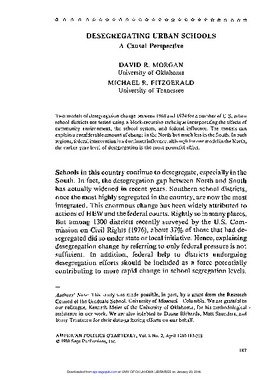| dc.contributor.author | David R. Morgan | |
| dc.contributor.author | Michael R. Fitzgerald | |
| dc.date.accessioned | 2016-01-14T19:53:43Z | |
| dc.date.accessioned | 2016-03-30T15:33:09Z | |
| dc.date.available | 2016-01-14T19:53:43Z | |
| dc.date.available | 2016-03-30T15:33:09Z | |
| dc.date.issued | 1980-04-01 | |
| dc.identifier.citation | Morgan, D. R., & Fitzgerald, M. R. (1980). Desegregating Urban Schools: A Causal Perspective. American Politics Research, 8(2), 187-208. doi: 10.1177/1532673x8000800203 | en_US |
| dc.identifier.uri | https://hdl.handle.net/11244/25409 | |
| dc.description.abstract | Two models of desegregation change between 1968 and 1974 for a number of U.S. urban school districts are tested using a block-recursive technique incorporating the effects of community environment, the school system, and federal influence. The models can explain a considerable amount of change in the North but much less in the South. In both regions, federal intervention is a dominant influence, although for one model in the North, the earlier year level of desegregation is the most powerful effect. | en_US |
| dc.language.iso | en_US | en_US |
| dc.publisher | American Politics Research | |
| dc.title | Desegregating Urban Schools: A Causal Perspective | en_US |
| dc.type | Research Article | en_US |
| dc.description.peerreview | Yes | en_US |
| dc.description.peerreviewnotes | https://us.sagepub.com/en-us/nam/manuscript-submission-guidelines | en_US |
| dc.identifier.doi | 10.1177/1532673x8000800203 | en_US |
| dc.rights.requestable | false | en_US |
